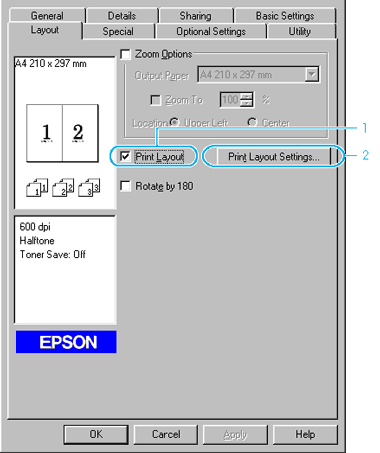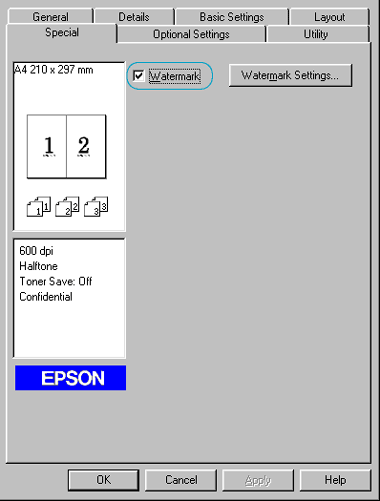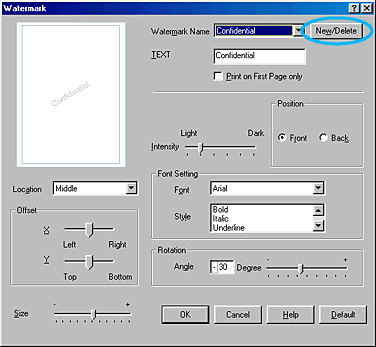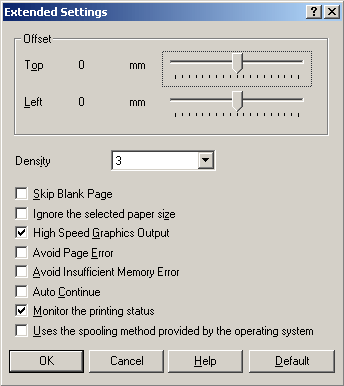|

Reference Guide
|
|
How To / Using the Printer Software with Windows
Making Changes to Printer Settings
 Resizing printouts
Resizing printouts
 Modifying the print layout
Modifying the print layout
 Using a watermark
Using a watermark
 Avoiding Insufficient Memory Error
Avoiding Insufficient Memory Error
Resizing printouts
You can have your document enlarged or reduced during printing.
To automatically resize pages to fit the output paper
 |
Click the Layout tab.
|
 |
Select the Zoom Options check box.
|

 |
Select the desired paper size from the Output Paper drop-down list. The page will be printed to fit on the paper you have selected.
|
 |
Click the Upper Left button (to print reduced page image at upper left corner of the paper) or the Center button (to print reduced page image with centering) for Location setting.
|
 |
Click OK to accept the settings.
|
To resize pages by a specified percentage:
 |
Click the Layout tab.
|
 |
Select the Zoom Options check box.
|
 |
Select the Zoom To check box.
|

 |
Specify the magnification percentage in the box, then click OK. The percentage can be set between 50% and 200% in 1% increments.
|
If necessary, select the paper size to be printed from the Output Paper drop-down list.

[Top]
Modifying the print layout
Your printer can print either two or four pages onto a single page and specifies the printing order, automatically resizing each page to fit the specified paper size. You can also choose to print documents surrounded by a frame.
 |
Click the Layout tab.
|
 |
Select the Print Layout check box, and click Print Layout Settings. The Print Layout Settings dialog box appears.
|

 |
Select the number of pages you want to print on one sheet of paper.
|

 |
Select the Page Order in which the pages are printed on each sheet. Select the Print the Frame check box when you want to print the pages surrounded by a frame.
|
 |  |
Note:
|
 |  | |
The Page Order choices depend on the number of pages selected above, and the paper orientation (Portrait or Landscape) selected on the Basic Settings menu.
|
|
 |
Click OK to close the Print Layout Settings dialog box.
|
 |
Click OK on the Layout menu to accept the settings.
|

[Top]
Using a watermark
Follow the steps to use a watermark on your document. In the Watermark dialog box, you can select from a list of predefined watermarks, or you can make an original watermark with text or a bitmap. The Watermark dialog box also allows you to make a variety of detailed watermark settings. For example, you can select the size, intensity, and position of your watermark.
 |
Click the Special tab.
|
 |
Select the Watermark check box.
|

 |
Click Watermark Settings. The Watermark dialog box appears.
|
 |
Select a watermark from the Watermark Name drop-down list.
|

 |
Select the location on the page where you want to print the watermark from the Location drop-down list.
|
 |
Adjust the horizontal or vertical Offset position.
|
 |
Adjust the image intensity of the watermark with the Intensity slider bar.
|
 |
Adjust the size of the watermark with the Size slider bar.
|
 |
Select Front (to print the watermark in the foreground of the document) or Back (to print the watermark in the background of the document) for the Position setting.
|
 |
Click OK to accept the settings.
|
Making a new watermark
You can make a new watermark as follows:
 |
Click the Special tab.
|
 |
Select the Watermark check box.
|
 |
Click Watermark Settings. The Watermark dialog box appears.
|
 |
Click New/Delete. The User Defined Watermarks dialog box appears.
|

 |
Select Text or BMP and type a name for the new watermark in the Name box.
|
 |
If you select Text, type the watermark text in the Text box. If you select BMP, click Browse, select the BMP file you want to use, then click OK.
|
 |
Click Save. Your watermark will appear in the List box.
|
 |
Click OK to register the new watermark settings.
|
 |
Note:
|
 | |
You can register up to 10 watermarks.
|
|

[Top]
Avoiding Insufficient Memory Error
When you print graphics or a large amount of data, the printer may stop due to insufficient memory. Follow the steps below to avoid memory errors and continue printing.
 |
Note:
|
 | |
Print quality will decrease when you use this function.
|
|
 |
Click the Optional Settings tab.
|
 |
Click Extended Settings. The following dialog box appears.
|

 |  |
Note:
|
 |  | |
This screen is a Windows XP, 2000, and NT 4.0 screen.
|
|
 |
Select the Avoid Insufficient Memory Error check box.
|
 |
Click OK to accept the settings.
|

[Top]
| Version 1.10E, Copyright © 2003, SEIKO EPSON CORPORATION |
Resizing printouts
Modifying the print layout
Using a watermark
Avoiding Insufficient Memory Error